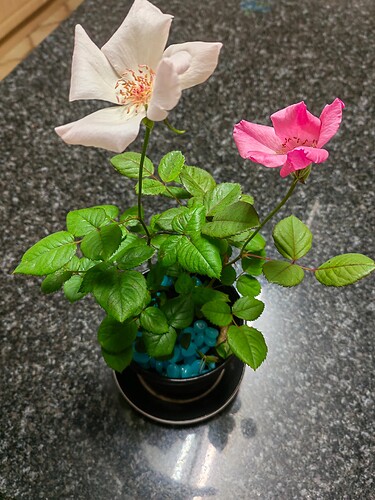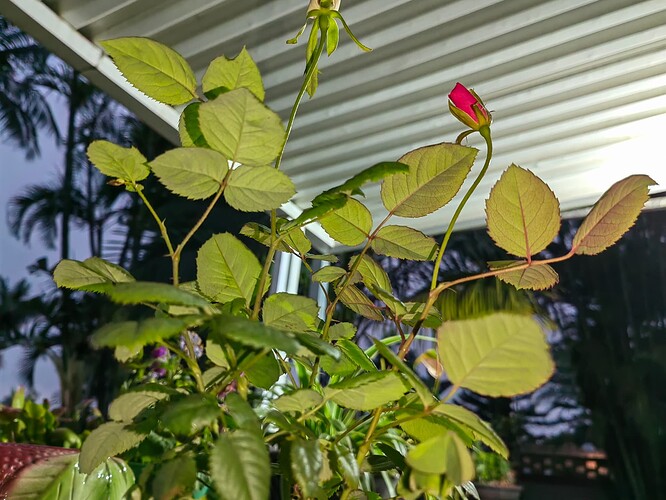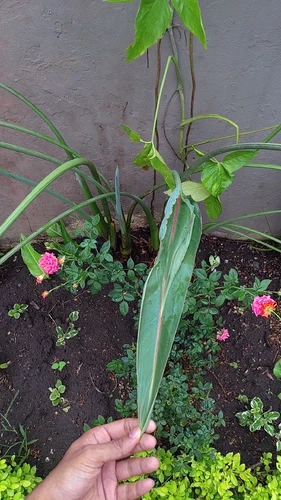In early 2024, I planted a rose seed obtained from the rosehip of a long-standing, ground-planted floribunda variety, suspected to be a hybrid of Rosa chinensis. Remarkably, the rose has displayed what I believe to be sectorial chimerism—a phenomenon I understand to be rare, particularly in a rose grown from seed.
The plant, now approximately 10 months old, has produced two distinct blossoms: one vibrant pink and the other white or pale pink. Post germination, I observed that the plant developed a Y-shaped trunk with two distinct stems. One stem produces the pink blossom and has prominently red-veined leaves on its newer growth, while the other stem produces the white blossom and exhibits greener foliage.
To support its initial growth after repotting the plant at 10cm growth milestone, I utilized a red and blue grow light for about two weeks. During this period, I encountered fungal contamination due to the use of a plastic humidity cover, which I resolved by increasing airflow and sunlight exposure. Additionally, I used a foliar spray containing harpin protein (Messenger) every three weeks, alternating with a product called Frutex, which allegedly enhances sap production and promotes larger flowers.
Interestingly, I suspect that the use of harpin protein may have influenced a genetic mutation event, potentially contributing to the observed sectorial chimerism. I would greatly value opinions on whether this hypothesis warrants further exploration as a possible variable in triggering such phenomena.
As a related observation, three months into this regimen, I noticed a peculiar morphological change in a Strelitzia reginae (Bird of Paradise) plant in my garden. After removing excess shoots from its root base, months later one of its leaves developed monstrous growth, where a second leaf is emerging from the central vein of the original leaf. This anomaly has further fueled my curiosity about the potential role of environmental or chemical factors in inducing genetic or morphological changes.
3 Likes
Monstrous growth strelitzia reginae
1 Like
Hi there! It’s my first time exploring this forum and I’m hoping for some insight on this phenomenon. Thank you kindly, and a happy new year to all!
Welcome @Indivisibleduality !
I really don’t know any useful answer your question, or whether the products applied played a role in the sporting /chimerism , but that’s a very cool seedling!
It will be interesting to see if this is stable and continues to show up in later blooms as the plant matures. I hope you will update us on its evolution.
Happy new year to your as well!
1 Like
Welcome to the the RHA forum!
While they may not be common, seedlings with single-trait chimeras/sports aren’t unheard of–most just tend to be fairly unremarkable (as are most seedlings!). In fact, I have a seedling right now that is producing lighter-colored flowers on one stem, but the color of the “original” part is more interesting. I doubt that the ingredients you mentioned are likely to have significant mutagenic potential, given their nature, history of horticultural use, and regulatory assessment. If you continue to suspect those products, it would probably take a larger sample of similar plants plus controls to begin to support the idea of a possible causal relationship. The odd seedling or plant here and there with a mutation can just as easily be attributed to chance.
I did notice that the leaves on the two sides of your container are different in ways that go beyond just their respective shades of green–the leaflet shape and petiolule length also look like they might be consistently distinct. While it is possible that there could be some mutation or sport involving multiple, unrelated traits, that would be less common than a single-characteristic sport involving only coloration. I know that I’ve also had surprise “twins” appear before when I thought that only one seed/seedling was potted up, so it would be good to rule that sort of thing out before moving on to more interesting explanations.
Odd, ephemeral mutations are pretty common overall, and are simply missed by many people. If the Strelitzia kept that up and the sport were ultimately stable enough to propagate, it might even make for an interesting new niche cultivar. Plants are sometimes selected for producing foliar growths like that in Japan, as in the case of Rohdea japonica, where the presence of raised, sometimes wavy leaf ridges is often indicated with cultivar names including the word “ryu” (“dragon”). It’s always fun to keep an eye out for plant mutations. Some in the horticulture industry refer to the activity cheekily as “sport fishing,” and if you have the knack for it, it can lead to all kinds of wonderful discoveries. Good observational skills are also key to productive plant breeding.
Stefan
2 Likes
Wow! Thank you for the thoughtful reply and enlightenment, I sincerely appreciate it.
I’ve pruned the flowers to allow for healthier growth in hopes that in it’s next bloom I can provide better documentation. I see now that chance plays fair in destiny, one’s observations included!


